
Wondering if Your 1982 Penny Is Worth Anything?
It might not make you rich, but your 1982 Lincoln penny could be worth more than just one cent.
This coin stands out from the rest because it represents a major transition in U.S. coinage — the switch from the traditional bronze alloy to a new copper-plated zinc composition. Even more intriguing is that the 1982 cent was minted in multiple varieties, making it a fascinating piece for collectors.
In this overview, we’ll cover:
- The history and design of the 1982 penny
- Its physical characteristics and metal makeup
- The different varieties minted that year
- How to determine if your coin is a rare and valuable find
1982 Lincoln Penny Overview
| Category | Lincoln Cent (Memorial Reverse) |
|---|---|
| Mint Locations | Philadelphia (no mint mark), Denver (D), San Francisco (S for proofs) |
| Obverse Designer | Victor D. Brenner |
| Reverse Designer | Frank Gasparro |
| Metal Composition | 95% copper with 5% tin and zinc (bronze); 97.5% zinc with 2.5% copper (plated) |
| Diameter | 19 mm |
| Weight | 3.11 g (bronze) or 2.5 g (zinc) |
| Edge | Plain |
The Obverse
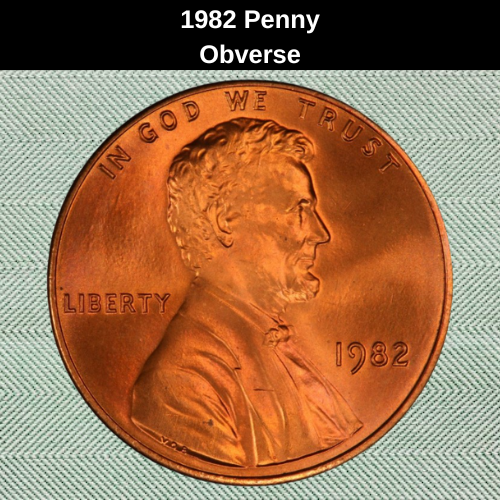
The Lincoln cent was first introduced in 1909 to mark the 100th birthday of President Abraham Lincoln — a tradition that continued with the 1982 penny.
This coin features a right-facing portrait of Lincoln on the obverse, designed by Victor D. Brenner. In the depiction, Lincoln is shown wearing a formal suit and bow tie, a dignified image that has become iconic in American coinage.
Above his head is the motto “IN GOD WE TRUST”, while the word “LIBERTY” is placed to the left side of the coin. On the right side, just beneath Lincoln’s chest, is the year “1982” — although it’s important to note that the size of the date varies depending on the specific variety of the penny.
The Reverse
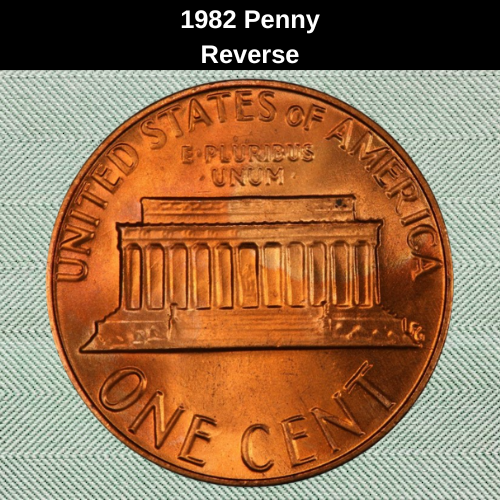
The reverse side of the 1982 penny carries a unique charm of its own. Departing from earlier designs featuring two wheat ears, this version displays the Lincoln Memorial, introduced in 1959.
That year, the U.S. Mint commissioned Frank Gasparro to replace Victor D. Brenner’s wheat motif with a new reverse design. Gasparro responded with the now-familiar image of the Lincoln Memorial, drawing inspiration from ancient Greek coinage, which often featured a deity on one side and their temple on the other.
Above the memorial sits the Latin phrase “E PLURIBUS UNUM”, meaning “Out of many, one.” Encircling the top of the coin is “UNITED STATES OF AMERICA,” while the denomination “ONE CENT” is placed along the bottom beneath the steps of the memorial.
Additional Specifications
The first type of 1982 penny was struck using the traditional bronze composition—95% copper and 5% tin and zinc—and weighs 3.11 grams, with a diameter of 19 millimeters.
The second type, introduced during the same year, marked the transition to a more cost-effective material: 97.5% zinc coated with 2.5% copper. These lighter coins weigh only 2.5 grams but retain the same 19 mm diameter.
Regardless of the metal composition, all 1982 pennies have a plain edge. They were produced at three U.S. mints:
- Philadelphia (no mint mark),
- Denver (marked with a “D”), and
- San Francisco (bearing an “S” for proof coins).
1982 Lincoln Penny Value Chart
(Values listed are for Red (RD) uncirculated examples, unless noted)
| Mint Mark | Variety | Circulated | Mint State (MS64) | Mint State (MS67) |
|---|---|---|---|---|
| No Mint Mark | Small Date (Copper) | – | $22 | $215 |
| Large Date (Copper) | – | $16 | $140 | |
| Small Date (Zinc-coated) | – | $4 | $65 | |
| Large Date (Zinc-coated) | – | $7 | $22 | |
| D (Denver) | Large Date (Copper) | – | $15 | $250 |
| Small Date (Zinc-coated) | – | $12 | $48 | |
| Large Date (Zinc-coated) | – | $8 | $45 | |
| S (San Francisco) | Proof (Zinc-coated) | – | $10 | $12 |
Note:
- These values are for Red (RD) specimens, which are the most valuable due to their luster.
- Copper and zinc versions differ in weight and composition.
- Prices may vary based on market demand and coin quality.
1982 Penny Grading Guide
Understanding your 1982 penny’s grade is essential for determining its true value. The coin’s grade reflects its physical condition and overall appearance, including details like luster, color, and wear. Coins are typically graded using the Sheldon Scale, which ranges from 1 to 70.
Below is a breakdown of the common grades:
| Grade Number | Grade Description |
|---|---|
| 1 | Basal State-1 |
| 2 | Fair |
| 3 | Very Fair |
| 4, 5, 6 | Good |
| 7, 8, 10 | Very Good |
| 12, 15 | Fine |
| 20, 30 | Very Fine |
| 40 | Extremely Fine |
| 50 | About Uncirculated |
| 60 | Mint State (MS 60) |
| 65 | Mint State (MS 65) |
| 70 | Mint State (MS 70 – Perfect Condition) |
1982 Penny Value and Varieties Guide
1982 no mint mark Penny Value

- Type: Lincoln Memorial Cent
- Edge: Plain
- Mint Mark: None
- Mint Location: Philadelphia
- Year: 1982
- Face Value: $0.01 USD
- Mintage: 10,712,525,000
In 1982, the Philadelphia Mint produced over 10.7 billion Lincoln cents, but these coins are notable for more than just their sheer numbers. That year marked a major transition in metal composition and date design.
Composition Changes
The year began with cents composed of 95% copper and 5% tin and zinc—often referred to as bronze or brass. Later in 1982, the Mint shifted to a new composition: copper-plated zinc, which dramatically reduced the coin’s weight and production cost.
Design Update – Large Date vs. Small Date
Midway through the year, the Mint updated the obverse hub, resulting in a noticeable difference in the date size. This created four distinct Philadelphia varieties:
1982 Large Date Bronze Penny
- Metal: 95% Copper (Bronze)
- Value (circulated): $0.05
- Value (MS60–MS66): $6 – $16
- Value (MS67+): Up to $140
1982 Small Date Bronze Penny
- Rarity: Rare and highly desirable
- Market Value: Significantly higher due to scarcity
- Color Impact: Red-luster coins command the highest premiums
- Auction Record: One MS67+ red specimen sold for $9,988 in 2014
1982 Large Date Copper-Plated Zinc Penny
- Metal: Zinc core, copper-plated
- Value (circulated): $0.04 – $0.50
- Value (MS67): Around $22
- Availability: Very common in all grades
1982 Small Date Copper-Plated Zinc Penny
- Rarity: Slightly less common than large date zinc
- Value (circulated): Low value
- High-Grade Premiums: A flawless MS69 red example sold for as much as $15,000
1982 “D” Penny Value
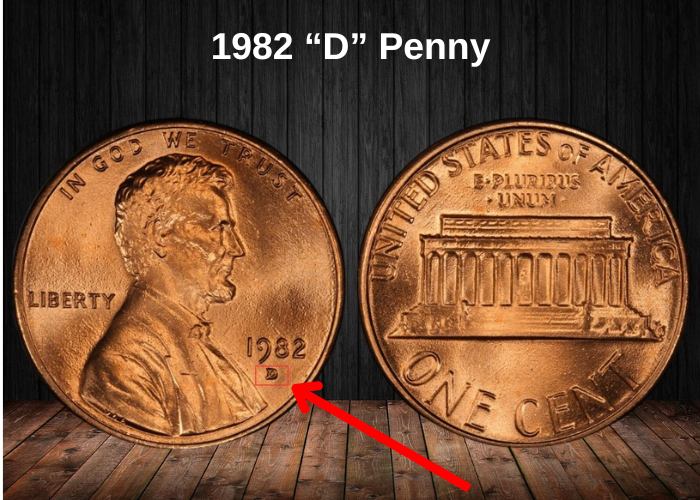
- Type: Lincoln Cent
- Edge: Plain
- Mint Mark: D
- Place of Minting: Denver
- Year of Minting: 1982
- Face Value: $0.01
- Mintage: 6,012,979,368
In 1982, the Denver Mint produced over 6 billion Lincoln cents, striking both bronze and copper-plated zinc versions. This was part of the U.S. Mint’s broader transition from bronze to zinc-based coinage during that year.
1982-D Bronze Penny
Prior to October 21, 1982, all Lincoln cents struck at the Denver Mint were made of a bronze alloy (95% copper, 5% tin and zinc). These coins exclusively feature a large date design.
Interestingly, a few rare small date bronze varieties have been discovered — a notable example being the specimen found by Paul Malone of Minnesota, which sold for $18,800 due to its rarity.
Value Estimates for 1982-D Large Date Bronze Penny:
- Circulated Condition: $0.04 – $0.50
- Uncirculated Condition: $6 – $15
- Mint State with Red Luster (MS65+): $80 – $750
1982-D Zinc-Coated (Copper-Plated) Penny
After the switch from bronze to copper-plated zinc later in 1982, the Denver Mint began producing zinc pennies. As the mint worked to speed up production, strike quality initially declined. To compensate, the mint modified the obverse design, resulting in two distinct date styles: large date and small date.
Value Comparison:
| Variety | Grade (MS64) | Grade (MS67) |
|---|---|---|
| 1982-D Large Date Zinc | $7 | $45 |
| 1982-D Small Date Zinc | $12 | $48 |
As with the bronze cents, small date varieties tend to be more sought-after and command higher prices, especially in higher mint state grades.
1982 “S” Penny Value Proof
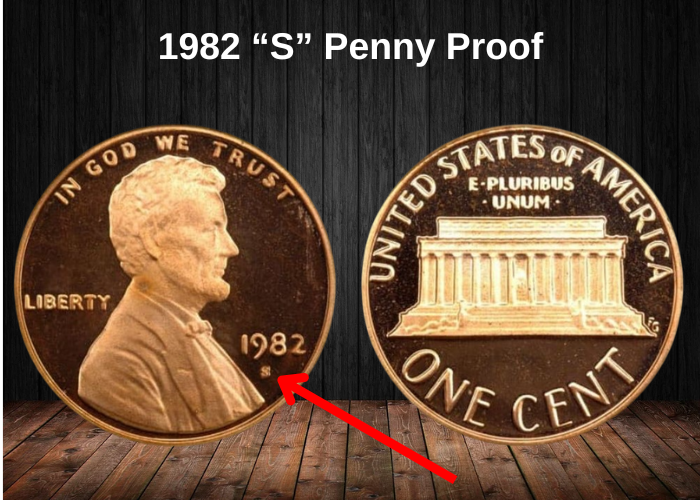
- Type: Lincoln Cent
- Edge: Plain
- Mint Mark: S
- Place of Minting: San Francisco
- Year of Minting: 1982
- Face Value: $0.01
- Mintage: 3,857,479
In 1982, the San Francisco Mint produced just over 3.8 million Lincoln cents, all bearing the “S” mint mark. These coins were not meant for everyday use—instead, they were specially struck as proof coins for collectors and investors, meaning they were never released into general circulation.
Key Characteristics
- Composition: All 1982-S proof pennies were made from copper-plated zinc (no bronze versions).
- Date Style: There are no small or large date varieties in this issue—only one standard design.
- Production Note: During minting, an issue emerged where the zinc core occasionally breached the copper plating under the intense pressure used for proof coins.
- Solution: The Mint resolved this problem by giving the planchets an additional copper plating layer, ensuring a flawless proof finish.
Public Circulation Anomaly
Interestingly, San Francisco also struck 1,587,245 Lincoln cents in 1982 for general circulation, but these coins lack any mint mark, making them indistinguishable from Philadelphia issues unless identified through specific diagnostics.
1982-S Proof Penny Value
Despite their lower mintage, most 1982-S proof cents remain affordable due to their availability in collector sets. Here’s a breakdown:
| Grade | Approximate Value |
|---|---|
| PR62 | $6.00 |
| PR65–PR69 | $6.00 – $6.50 |
| PR70 Deep Cameo | Up to $7,050 (Auction Record in 2013) |
While most pieces trade at modest prices, exceptional specimens with deep cameo contrast and perfect grading (PR70) can command thousands at auction.
1982 Penny History
Before 1982, copper pennies were highly regarded for their durability and attractive appearance. However, 1982 marked a major turning point in the history of U.S. coinage, prompted by economic shifts and rising metal costs.
The Copper Crisis Begins
The issue dates back to the early 1970s. In 1973, the price of copper rose so significantly that melting Lincoln cents for their metal content almost became more profitable than their face value. While this didn’t become a widespread problem, it pushed the U.S. Mint to explore alternatives to the standard 95% copper and 5% zinc alloy.
Aluminum Experiments
In response, the Mint experimented with aluminum cents, striking approximately 1.5 million 1974-dated aluminum coins in anticipation of congressional approval. However, Congress ultimately rejected the proposal, and nearly all the aluminum cents were recalled and destroyed.
Final Push for Change
By 1979, the price of copper reached the point where one pound exceeded one U.S. dollar, further increasing the urgency to find a new, cost-effective composition. In 1981, Congress approved a major change: the Lincoln cent would be made of 99.2% zinc with a 0.008-inch copper plating, drastically reducing its copper content to just 0.04%.
Transition to Zinc Pennies
The shift officially began on January 7, 1982, with the first copper-plated zinc pennies produced at the West Point Mint. However, these coins carry no mint mark, making them indistinguishable from those minted in Philadelphia.
The Philadelphia Mint soon took over zinc penny production, while the Denver Mint continued producing bronze cents until October 21, 1982, completing the transition later in the year. Denver would go on to mint over 6 billion coins that year.
San Francisco’s Role
Meanwhile, the San Francisco Mint contributed by producing:
- Over 1.5 million regular strike cents (without mint marks)
- More than 3 million proof pennies, specially made for collectors
A Year of Varieties
This transition led to the creation of multiple 1982 penny varieties, distinguished by:
- Metal composition (bronze vs. zinc)
- Date size (large date vs. small date)
- Mint marks (Philadelphia [none], Denver [D], San Francisco [S])
These unique variations are now a point of interest for collectors and can significantly influence the coin’s value.
Rare 1982 Penny Error List
1982 Penny Value Double Die Error
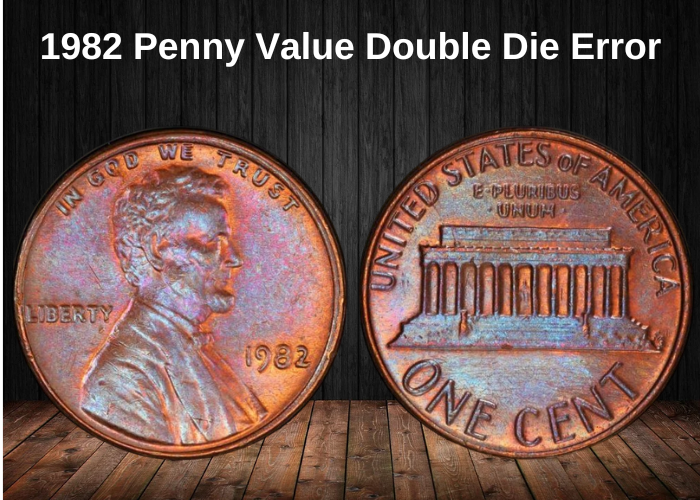
One of the most notable and collectible errors found in 1982 Lincoln cents is the doubled die error. This error occurs when a worn or misaligned die strikes a blank planchet more than once, causing a visible doubling of certain design elements.
This type of error is most commonly found on 1982 Lincoln cents with no mint mark (struck in Philadelphia). To identify a doubled die, examine the obverse and reverse lettering closely—doubling is often noticeable on inscriptions like “IN GOD WE TRUST,” “LIBERTY,” and the date. Some 1982 Denver (“D”) minted pennies may also show slight doubling, particularly around Lincoln’s ear.
Depending on the coin’s condition and degree of doubling, 1982 doubled die pennies can fetch anywhere from $150 to $200, making them a prized find for collectors.
1982 Penny Value Occluded Gas Bubbles Under Plating Error
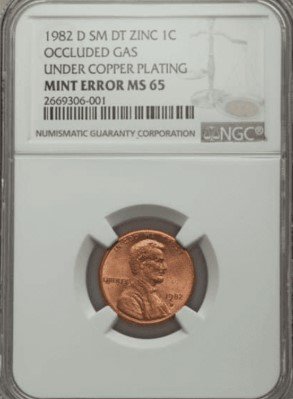
Another noteworthy error found in 1982 Lincoln cents is the occluded gas bubble under the plating. This error occurs when the intense heat generated during the striking process causes air pockets to become trapped beneath the surface of the coin. As a result, small raised bumps or bubbles appear, usually visible on the coin’s surface.
This issue is more common in zinc-based 1982 pennies, particularly those minted in Denver (“D”), as the copper-plated zinc composition is more prone to this type of flaw.
In 2016, a 1982-D penny featuring occluded gas bubbles sold for $39, illustrating that even minor minting defects can add collectible value when properly identified.
1982 Penny Value Struck Off-Center Error
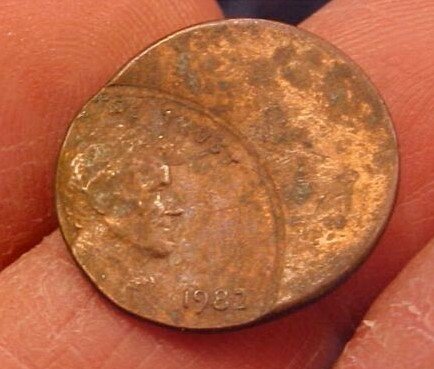
Lastly, one of the most sought-after minting errors by collectors is the off-center strike. As the name implies, this error occurs when the coin’s design is not properly aligned during the striking process, resulting in a portion of the design being stamped off-center. The more dramatic the misalignment, the more valuable the coin becomes—especially if the date remains fully visible.
These off-center 1982 pennies can fetch anywhere from $90 to $120, depending on the percentage of the off-center strike, as well as the coin’s color and overall condition.
Where to sell your penny?
Now that you know the value of your penny, you might be wondering where to sell it. Don’t worry: here’s a guide to some of the best online platforms where you can easily sell your coins, along with their advantages and disadvantages.
Discover the best platforms for selling coins online (pros and cons).
1982 Lincoln Penny – Advanced FAQs
1. Why is the 1982 penny one of the most important transitional coins in U.S. numismatics?
The 1982 penny is historically significant because the U.S. Mint transitioned from a 95% copper composition to copper-plated zinc (97.5% zinc, 2.5% copper) that year. This change was made to reduce production costs as copper prices rose. This resulted in 7 different varieties of 1982 pennies—based on composition, mint mark, and large vs. small date.
2. What are the 7 known varieties of the 1982 Lincoln cent?
The 1982 penny was struck in the following varieties:
| Variety | Composition | Date Style | Mint |
|---|---|---|---|
| 1982 Large Date | Copper | Large | Philadelphia |
| 1982 Small Date | Copper | Small | Philadelphia |
| 1982 Large Date | Zinc | Large | Philadelphia |
| 1982 Small Date | Zinc | Small | Philadelphia |
| 1982-D Large Date | Copper | Large | Denver |
| 1982-D Large Date | Zinc | Large | Denver |
| 1982-D Small Date | Zinc | Small | Denver (RARE!) |
The 1982-D Small Date made of copper was not officially released, but some examples exist and are extremely rare.
3. How can I tell whether my 1982 penny is copper or zinc?
You can test the composition using these methods:
- Weighing:
- Copper pennies weigh 3.11 grams
- Zinc pennies weigh 2.5 grams
- Sound test: Drop both on a hard surface. The copper coin makes a ringing sound, while the zinc one has a dull thud.
Using a precise scale is the most accurate method for identifying composition.
4. Are 1982 pennies valuable? What are the most valuable varieties?
Most 1982 pennies are common and worth 1 to 5 cents in circulated condition. However:
- Uncirculated copper or zinc coins in MS65+ can fetch $5 to $25+.
- The 1982-D Small Date copper penny is extremely rare and has sold for over $10,000 at auction.
- High-grade Small Date Zinc coins can also fetch $50–$250+ depending on condition.
5. What’s the difference between the large and small date 1982 cents?
The differences are subtle:
- Small Date: The “8” is more symmetrical, and the “2” has a sharper curve.
- Large Date: The “8” looks more lopsided and rounded; the “2” has a more open curve.
You need a side-by-side comparison or a magnifier to easily distinguish them.
6. Are there proof versions of the 1982 penny?
No, there were no proof pennies minted in 1982. The U.S. Mint temporarily suspended proof coinage that year, so any “shiny” 1982 cent found in circulation is likely just a well-preserved business strike.
7. Is it worth getting a 1982 penny graded?
Only certain 1982 pennies are worth grading:
- High-grade MS66 or better Red examples (especially Small Date varieties).
- The extremely rare 1982-D Small Date Copper.
- Coins with visible errors like doubled dies, off-center strikes, or cuds.
For most circulated examples, the grading cost will exceed the coin’s market value.


















































